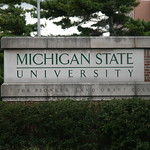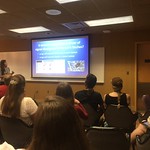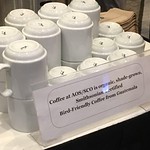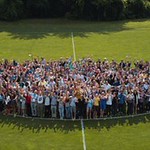Amy Strauss GRAD SCHOOL DIARIES
birds bird summer postcard
Greetings from Michigan: American Ornithology Conference 2017
Part of a new TLS post series, Postcards from Science! Our intrepid scientists and bloggers write home with tales of their summer science adventures.
To: That’s Life [Science] Headquarters
1 Science Communication Drive
Science Internet, Earth
From: Amy “Bird Nerd” Strauss
c/o American Ornithological Society (AOS)
Kellogg Hotel and Conference Center
Michigan State University
East Lansing, MI

Fig. 1 Greetings from Michigan State University (MSU) in East Lansing, MI! MSU hosted the Joint Meeting of the American Ornithological Society and the Society of Canadian Ornithologists in August 2017. (Image by Branislav Ondrasik, Wikimedia Commons. https://upload.wikimedia.org/wikipedia/commons/2/22/Michigan_State_University_sign.JPG)
Dear TLS friends,
I’m writing to you from my dorm room at Michigan State University (Fig. 1), where I’ve just come back from breakfast at the campus dining hall. I’m here for a professional scientific meeting – the 135th Meeting of American Ornithology, a joint effort between the American Ornithological Society and the Society for Canadian Ornithologists. As a 4th-year PhD student eager to pursue a career in the field of ornithology, this meeting is a big deal! Famous ornithologists from far and wide have gathered together to talk about the latest and greatest in bird research – and I’m here to join in the conversation, learn as much as possible, and network like crazy. It is quite the juxtaposition trying to put on my most professional persona and dress for success while simultaneously sleeping in a college dorm room and filling a cafeteria tray with all-you-can-eat cereal and mass-produced eggs for breakfast. Feeling both the ‘flash-forward-career-aspiration’ vibes and the ‘flashback-college-nostalgia’ vibes is pretty exciting (and anxiety-inducing!).
The conference runs from July 31st-August 5th, and every day is jam-packed. The bulk of the schedule centers around concurrent sessions that take place all day across eight conference rooms, in which researchers get 15-minute windows to present their research. Each session has a different unifying theme (such as, “Migration and Movement”, “Mating Systems and Sexual Selection”, or “Climate Change”), but even within a single session the topics can be surprisingly varied. For example, I study birdsong and I presented during a session titled, “Communication and Song”. I discussed the role that habitat plays in shaping the evolution of song in Darwin’s finches (Fig. 2). In my session, research presentations covered: how industrial noise from oil compressor stations affects songbirds, how and why song complexity and continental geography may be correlated, how quiet singing in some species is actually a super threatening signal of aggression, etc. At the same time, another session was running where the speakers discussed how nesting ecology and mating behavior are linked in the Cordilleran Flycatcher. If you’re like me and you love learning about bird biology, this conference is like going to a candy store and having to pick just one sweet treat. Everything on the schedule looks exciting, and it’s a struggle to choose among the eight talks available at any given time because they all look so intriguing!

Fig. 2 Here I am giving a 15-minute talk about my research during one of the presentation sessions at the conference. My undergraduate advisor snapped this photo from the audience, and posted it on twitter with a 140-character summary of my talk! (Image by Tim Parker, with permission. https://twitter.com/TimParker88/status/893856828416823296)
In addition to the concurrent research talk sessions, there are useful workshops for gaining technical skills (i.e. ‘Drone technology for ornithologists’), broad discussions about the future of ornithology (i.e. ‘Increasing diversity in ornithology’), and helpful sessions on public engagement and science communication (i.e. ‘A public policy primer for ornithologists’). There are social events designed to foster non-academic interactions between meeting attendees (i.e. ‘LGBTQA social’, ‘All-out ostrich scramble 5K’, and ‘Early morning bird walks’), and there are more formal opportunities to connect professionally (i.e. ‘Student and mentor lunch’, and ‘Meet the journal editors’). Not to mention all of the research presented in poster form at two evening poster sessions (which are essentially grown-up Science Fairs – with alcohol)!

Fig. 3 Scientist fuel = coffee. Ornithologist fuel = organic, shade-grown, Smithsonian Certified Bird-Friendly Coffee from Guatemala. (Image by Kaycee Morra, with permission.)
This meeting can be overwhelming, but the effort I have put into making new connections has proven rewarding. Yesterday, I got up the nerve to speak with a faculty member from Costa Rica who cited a bioacoustics analysis method I’ve been trying to run for months – not only did he explain to me how to use it, but he gave me the correct software program via his thumb drive and sat with me for an hour to walk me through the steps. Multiple people came up to me after my talk with ideas about how to address some of the specific challenges I’ve been facing with my particular data set. I reconnected with my undergraduate advisor, the person who initially got me excited about birds back in 2008. And I even found another graduate student to be my dancing buddy for the Bird Jam music fest!
While I’m not going to be able to forge unique relationships with all 700+ conference attendees (Fig. 4), each moment of connection, each new idea, and each reinvigorating reminder that this research genuinely excites me help motivate me in my mission as a PhD student: to discover something new and contribute to our collective understanding of how the world works. Gotta love science!

Fig. 4 Here are the over 700 ornithologists that gathered in Michigan to discuss hot topics in ornithology, share research findings, and forge scientific collaborations. Can you find me? (Image by Matthew Dae Smith for MSU, with permission.)
I’ll send another postcard from the 136th Meeting of the American Ornithological Society, taking place next April 2018 in Tucson, Arizona! In the meantime, it’s back to work so I can have some exciting new research to present there…
Until then – stay curious.
Cheers,
Amy
